Why Farmers Deserve Price Security
- 11 Jan 2025
Introduction:
The future of Indian agriculture is at a crossroads. With the shrinking of the agricultural workforce and the diversion of fertile farmlands for urbanization, ensuring the sustainability of farming is a strategic imperative. Among the various support mechanisms for farmers, the Minimum Support Price (MSP) remains a central point of debate. Should there be a legal guarantee for MSP? This question has gained prominence, especially with the rising challenges in agriculture, from unpredictable climate patterns to volatile market prices.
The Decline of Agriculture and Its Impact
India’s agricultural sector faces a dual crisis: loss of both land and human resources. Prime agricultural lands across river basins, such as the Ganga-Yamuna Doab or the Krishna-Godavari delta, are being repurposed for real estate, infrastructure, and industrial projects. Additionally, the number of "serious farmers" – those deriving at least half of their income from agriculture – is dwindling. The number of operational holdings may be 146.5 million, but only a small fraction of these farmers remains committed to agriculture.
This decline threatens the future of India’s food security, as the country will need to feed a population of 1.7 billion by the 2060s. To sustain farming and ensure long-term food security, we must secure farmers' livelihoods. Price security, particularly through MSP, plays a crucial role in this context.
The Role of MSP in Securing Farmers
MSP is the government-mandated price at which it guarantees the purchase of crops if market prices fall below a certain threshold. It provides a safety net for farmers against price volatility. The process of fixing MSP involves recommendations by the Commission for Agricultural Costs and Prices (CACP), which takes into account factors such as the cost of production and market trends. Once approved by the Cabinet Committee on Economic Affairs (CCEA), MSP is set for various crops, including rice, wheat, and sugarcane.
For farmers to stay in business, there must be a balance between production costs and returns. Farming is a risky business – yield losses can occur due to weather anomalies, pest attacks, or other natural factors. However, price risks can be mitigated with a guaranteed MSP. This would encourage farmers to invest in their land and adopt modern farming technologies, which would boost productivity and reduce costs.
Arguments for and Against Legal MSP Guarantee
Supporters of a legal MSP guarantee argue that it would provide financial security to farmers, protecting them from unpredictable market conditions. It would also promote crop diversification, encourage farmers to shift from water-intensive crops to those less dependent on irrigation, and inject resources into rural economies, thus addressing distress in rural areas.
However, critics highlight several challenges with a legal guarantee for MSP. The most significant concern is the fiscal burden it would impose on the government, potentially reaching Rs. 5 trillion. Furthermore, such a system could distort market dynamics, discouraging private traders and leading to a situation where the government becomes the primary buyer of agricultural produce. This could be economically unsustainable, especially for crops with low yields. Additionally, legal MSP guarantees could violate World Trade Organization (WTO) subsidy principles, adversely impacting India’s agricultural exports.
The Way Forward: A Balanced Approach
Given the challenges associated with a legal MSP guarantee, alternative measures should be explored. Price Deficiency Payment (PDP) schemes, such as those implemented in Madhya Pradesh and Haryana, could be expanded at the national level. These schemes compensate farmers for the difference between market prices and MSP, ensuring price security without the fiscal burden of procurement.
Additionally, the government can focus on improving agricultural infrastructure, such as cold storage facilities, to help farmers better access markets and increase price realization. Supporting Farmer Producer Organizations (FPOs) could also help farmers by enhancing collective bargaining power and ensuring better prices for their produce. Moreover, gradual expansion of MSP coverage to include a wider range of crops would encourage diversification, reducing the dominance of rice and wheat.
Free Movement Regime
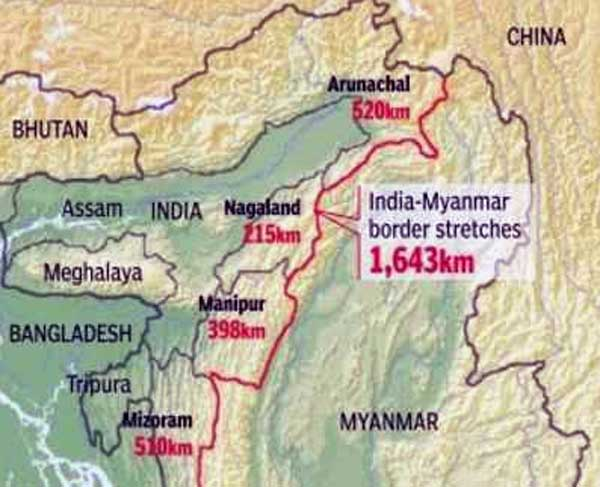
- 27 Dec 2024
In News:
The Indian government, through the Ministry of Home Affairs (MHA), has recently issued new guidelines to regulate the movement of people between India and Myanmar, especially along the border regions. These guidelines come after the suspension of the Free Movement Regime (FMR), which had previously allowed residents within a specified range of the border to move freely. The new protocol aims to enhance internal security and address concerns related to demographic shifts in India's northeastern states.
Background of the Free Movement Regime (FMR)
What is FMR?
The Free Movement Regime (FMR) is a bilateral arrangement between India and Myanmar that permits residents living in border areas to cross the international boundary without a visa. This agreement was established in 1968 to facilitate familial, cultural, and economic exchanges between people living on either side of the border.
Territorial Limits and Evolution
Initially, the FMR allowed free movement within a 40 km radius from the border. However, in 2004, this limit was reduced to 16 km, and additional regulations were introduced in 2016. The most recent development sees the limit further reduced to 10 km, with stricter regulations implemented to regulate the movement.
Recent Developments and New Guidelines
Suspension of FMR
In February 2023, Union Home Minister Amit Shah announced the suspension of the FMR along the India-Myanmar border, citing concerns about internal security and demographic changes, particularly in India's northeastern states. This decision came in the context of growing ethnic violence and political pressures, especially from states like Manipur.
Despite the announcement, the formal scrapping of the FMR is yet to be officially notified by the Ministry of External Affairs (MEA). However, the MHA has issued new guidelines to regulate cross-border movement, focusing on enhancing security without completely discontinuing the regime.
Key Features of the New Guidelines
The updated protocols issued by the MHA include several measures aimed at improving the security and regulation of movement across the border:
- Reduced Movement Limit: The new guidelines reduce the free movement limit from 16 km to 10 km from the border on both sides.
- Border Pass System: Residents wishing to cross into Myanmar or return to India must obtain a "border pass" from the Assam Rifles. This pass allows a stay of up to seven days in the neighboring country.
- Document and Health Checks: Upon entry into India, individuals will undergo a document inspection by the Assam Rifles, followed by security and health checks conducted by state police and health authorities. Biometrics and photographs will be collected, and a QR code-enabled border pass will be issued for verification.
- Designated Entry Points: There will be 43 designated entry and exit points across the border, with biometric verification and health screening required at all points.
- Monitoring and Enforcement: The Assam Rifles will oversee the movement, ensuring that individuals comply with the new regulations. Violations of the movement protocol will result in legal action.
Infrastructure and Technology Implementation
The government plans to establish infrastructure, such as biometric machines and software for border pass issuance. Pilot entry and exit points will be operational soon, with a phased implementation for the remaining points.
Political Reactions and Opposition
Regional Concerns and Opposition
The suspension of the FMR has been a contentious issue in India's northeastern states. The governments of Nagaland and Mizoram have raised objections to the scrapping of the regime, citing the cultural and familial ties of border communities. The Nagaland Assembly passed a resolution opposing the government's decision, while political leaders in Manipur argued that the unregulated movement of people had contributed to ethnic violence in the region.
Specific Concerns in Manipur
The chief minister of Manipur, N. Biren Singh, attributed ongoing ethnic conflicts in the state to the unchecked movement of people across the border. This was particularly evident in the violent ethnic clashes that broke out in 2023. As a result, Singh urged the Home Ministry to cancel the FMR along the India-Myanmar border, and the new guidelines reflect the state's concerns.
Conclusion
The suspension of the Free Movement Regime along the India-Myanmar border, followed by the introduction of stricter guidelines, marks a significant shift in India's border management policy. While the formal scrapping of FMR is yet to occur, the new protocols aim to balance security concerns with the region's long-standing cultural ties. The implementation of biometric checks and designated entry points signifies the government’s focus on modernizing border control while addressing regional concerns. The outcome of this policy shift will have important implications for internal security, demographic dynamics, and bilateral relations between India and Myanmar.
Commitment to Eradicating Naxalism in Chhattisgarh by 2026
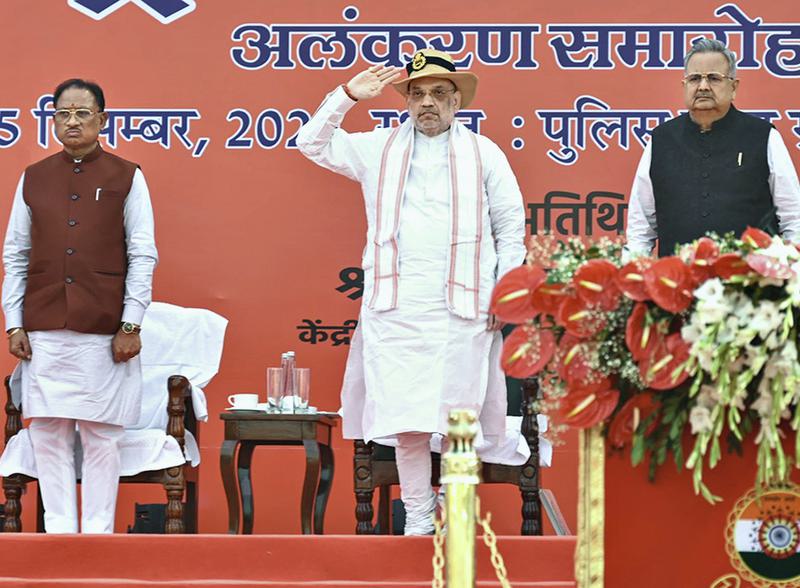
- 17 Dec 2024
Overview
Union Home Minister Amit Shah has reiterated India's commitment to eliminate Naxalism in Chhattisgarh by March 31, 2026. He emphasized the progress made in the fight against Naxalism, highlighting key successes and outlining the strategy for the coming years.
Key Pointers
- Government Commitment: Amit Shah emphasized the joint commitment of the Government of India and the Chhattisgarh state leadership to rid the state of Naxalism by 2026.
- Security Forces’ Success: Over the past year, Chhattisgarh police neutralized 287 Naxalites, arrested around 1,000, and saw 837 surrenders.
- Top Naxal Cadres Neutralized: The state forces successfully neutralized 14 high-ranking Naxal cadres.
- President’s Police Colour Award: Chhattisgarh Police received the President's insignia within 25 years, a significant achievement for the state.
The Three-Pronged Strategy for Eliminating Maoist Insurgency
- Security Measures (Force)
Deployment of Security Forces
- Enhanced Presence: Increased deployment of Central and State police forces in Left-Wing Extremism (LWE) areas.
- Joint Operations: Coordinated operations between state and central forces, including CRPF and COBRA units.
- Upgraded Technology: Incorporation of UAVs, solar lights, and mobile towers to enhance operational efficiency.
Operation SAMADHAN
- Key Elements:
- Smart Leadership: Leading with innovative strategies.
- Aggressive Strategy: Swift, decisive action against insurgents.
- Motivation and Training: Strengthening the capabilities of forces.
- Actionable Intelligence: Real-time intelligence for effective operations.
- Harnessing Technology: Using modern tech for strategic advantage.
2. Development Initiatives
Focused Development Schemes
- PMGSY: Rural road connectivity under the Pradhan Mantri Gram Sadak Yojana.
- Aspirational Districts Program: Improving infrastructure in Naxal-affected areas.
- Skill Development: Targeted schemes in 47 LWE-affected districts to reduce unemployment.
Infrastructure Development
- Special Infrastructure Schemes: Building schools, roads, and bridges in remote areas to integrate them into the mainstream economy.
- Rehabilitation: Focus on providing rehabilitation for former Naxals through education and vocational training.
3. Empowerment (Winning Hearts and Minds)
Public Engagement
- Tribal Empowerment: Strengthening communication with tribal communities to reduce alienation and mistrust.
- Rehabilitation Policies: Surrender schemes offering incentives like education and financial aid to reintegrate former insurgents into society.
Maoism: Ideology and Background
What is Maoism?
- Origin: A form of communism developed by Mao Tse Tung, focusing on armed insurgency to capture state power.
- Core Beliefs: Maoists believe in violence and insurrection as legitimate means to overthrow the state and establish a People’s Democratic Republic.
- Indian Maoism: The Communist Party of India (Maoist), formed in 2004, leads the largest Maoist insurgency in India.
Recent Achievements in Combatting Maoist Insurgency
Key Successes in 2023
- Maoist-Free Villages: Villages in Dantewada declared "Maoist-free," a significant victory for the state.
- Reduction in Security Forces’ Casualties: 14 deaths in 2024, a dramatic decrease from 198 deaths in 2007.
- Infrastructure and Logistical Support: Enhanced use of helicopters and fortified police stations.
Government’s Commitment to Rebuilding
- Rehabilitation and Welfare: The government is implementing policies to improve the living standards of affected families, including 15,000 houses for Naxal-affected regions.
- Economic Development: Focus on building infrastructure and providing employment through skills training programs.
Challenges in Eliminating Naxalism
Socio-Economic Issues
- Exploitation of Tribals: Marginalization of tribals due to displacement for mining and forestry.
- Lack of Infrastructure: Basic amenities like roads, schools, and healthcare are absent in many areas.
- Centralized Naxal Command: The CPI (Maoist) retains a strong leadership, despite fragmentation of its forces.
Governance and Trust Issues
- Alienation of Local Populations: Ineffective governance and poor implementation of welfare schemes fuel local support for Naxal groups.
- Resource Conflict: The Naxals exploit rich mineral resources in the region to fund their insurgency.
Way Forward
Governance and Economic Reforms
- Tribal Empowerment: Form Tribal Advisory Councils as per the Fifth Schedule for better resource management.
- Land Redistribution: Enforce the Land Ceiling Act to reduce inequality.
- Livelihood Programs: Offer alternative livelihoods to reduce dependency on illegal activities.
Security Measures
- Paramilitary Deployment: Specialized forces to secure tribal areas and enable local governance.
- Resource Management: Ensure sustainable exploitation of natural resources, involving tribal communities in the decision-making process.
Peace Dialogues
- Inclusive Policies: Engage in dialogue with Naxals to facilitate their reintegration into mainstream society.
Conclusion
Naxalism in India, particularly in Chhattisgarh, is a complex issue rooted in socio-economic inequalities, lack of development, and historical alienation of tribal communities. The government's approach, encapsulated in the SAMADHAN strategy, combines security operations with developmental initiatives and a focus on empowerment to tackle the problem. With a clear commitment to eliminate Naxalism by 2026, the Indian government is making significant strides in reducing violence, improving governance, and integrating affected communities into the mainstream.
Beware of Digital Wedding Invites

- 08 Dec 2024
In News:
In the peak wedding season, cyber fraudsters are increasingly exploiting digital wedding invitations to hack into mobile phones. These fraudulent invites, often disguised as PDF wedding cards shared on WhatsApp, contain embedded malware that allows cybercriminals to gain full access to the victim's phone. This includes access to sensitive financial data, making individuals vulnerable to fraud. The Lucknow Police Cyber Cell has issued a public warning, urging citizens to be cautious and avoid opening suspicious files.
How the Scam Works
The scam involves cybercriminals sending out malware-laden wedding invitations. Once the recipient opens the file, the malware infects their phone, enabling the fraudsters to remotely control the device. From there, they can access sensitive information, including bank account details, and may even transfer funds without the victim’s consent.
Preventive Measures and Cyber Hygiene
To protect against such scams, individuals should follow these preventive steps:
- Avoid Suspicious Files: Do not open files from unknown senders, particularly those with extensions like APK, PIF, or VBS. It is crucial to verify the sender's number—legitimate Indian numbers typically begin with +91.
- Turn Off Auto-Download: Disabling automatic downloads on platforms like WhatsApp can prevent files from being opened unknowingly.
- Enable Two-Step Verification: Strengthen security by activating two-step verification on your digital accounts and setting strong passwords.
- Report Fraud Immediately: In case of suspicious activity, contact the cybercrime helpline at 1930 or file a complaint on the official cybercrime portal (www.cybercrime.gov.in).
The Lucknow Police’s “Cyber Pathshala” campaign aims to raise awareness and educate the public on digital scams, particularly during the wedding season when these frauds are at their peak.
Cybersecurity Challenges in India
This emerging digital threat is part of a broader trend of sophisticated cybercrimes in India. Cyber fraudsters are increasingly using manipulative tactics, such as phishing, fake digital arrests, and malware attacks. In 2024, India witnessed a significant rise in ransomware attacks, frauds targeting financial institutions, and supply chain vulnerabilities.
India's legislative and institutional frameworks are evolving to address these challenges. Key measures include:
- The Information Technology Act, 2000, which lays the foundation for tackling cybercrimes.
- The Digital Personal Data Protection Act, 2023, which focuses on protecting personal data.
- The Indian Computer Emergency Response Team (CERT-In), which coordinates national responses to cyber incidents.
Additionally, new frameworks like the National Cyber Security Policy, 2013, and initiatives such as Cyber Surakshit Bharat and the Indian Cyber Crime Coordination Centre (I4C), aim to fortify India's digital landscape and promote cybersecurity.
Emerging Cyber Threats
As India becomes more digitally connected, the threat landscape continues to evolve:
- Digital Arrest Scams: Fraudsters impersonate law enforcement to extort money from victims, claiming they are under investigation for fictitious crimes.
- Ransomware: Attacks on critical infrastructure, such as financial institutions and healthcare systems, have led to operational disruptions and financial losses.
- Deepfake Technology: The rise of AI-generated deepfakes poses significant risks, including misinformation and financial fraud.
- Internet of Things (IoT) Vulnerabilities: The rapid adoption of IoT devices has created new security challenges, with many devices lacking adequate protection.
Strategic Recommendations for Enhancing Cybersecurity
To counter these evolving threats, India must focus on several strategic areas:
- Digital Literacy Campaigns: Nationwide efforts to improve digital literacy, particularly targeting vulnerable groups such as rural populations and senior citizens.
- Stronger IoT Security Protocols: Mandating secure design and certification for IoT devices.
- AI-Driven Threat Intelligence: Implementing AI-based tools for early threat detection and response in critical sectors.
- Mandatory Cybersecurity Audits: Regular audits of critical infrastructure, especially in sectors like healthcare, banking, and utilities.
- Public-Private Collaboration: Strengthening partnerships to address challenges such as cryptocurrency fraud, ransomware, and dark web-enabled crimes.
Conclusion
The rise of digital fraud, including the manipulation of wedding invitations for malicious purposes, highlights the need for enhanced cybersecurity measures in India. By improving public awareness, investing in technological solutions, and reinforcing legal and institutional frameworks, India can better protect its citizens from the growing threat of cybercrime. A proactive and informed approach is essential to secure the digital future of the nation.
Current Representation of Women in CAPFs

- 04 Dec 2024
In News:
The Central Armed Police Forces (CAPFs) of India, comprising forces like CRPF, BSF, CISF, and others, play a crucial role in maintaining internal security. Women’s participation in these forces has been historically limited, but recent efforts have focused on increasing their representation. As of 2024, women constitute only 4.4% of the total personnel in CAPFs, highlighting the slow progress despite various initiatives.
Current Representation and Changes Over Time
- Overall Representation: Women make up 4.4% of the 9.48 lakh-strong CAPFs. Within this, the Central Industrial Security Force (CISF) has the highest representation at 7.02%, followed by the Sashastra Seema Bal (SSB) at 4.43%, Border Security Force (BSF) at 4.41%, Indo-Tibetan Border Police (ITBP) at 4.05%, Assam Rifles at 4.01%, and Central Reserve Police Force (CRPF) at 3.38%.
- Growth of Women Personnel: From 15,499 women in 2014, the number has tripled to 42,190 in 2024, reflecting a steady increase in recruitment. However, the percentage remains low despite these gains.
- Recruitment Trends: In 2024, 835 women were recruited, with 5,469 more in the process. In 2025, 4,138 women are expected to be recruited.
Government Efforts and Parliamentary Committee Recommendations
- Policy Measures: The government has introduced several steps to encourage women’s participation in CAPFs, such as reservations in constable-level positions: one-third for CRPF and CISF, and 14-15% for border forces like BSF, SSB, and ITBP.
- Challenges in Recruitment: Despite these policies, recruitment has not kept pace with the targets. The 2022 Parliamentary Committee on Home Affairs expressed disappointment over the “abysmally low” number of women in CAPFs, noting that women made up only 3.68% of the forces at that time.
- Recommendations by Parliamentary Committees:
- The Home Affairs Committee recommended fast-tracking phase-wise recruitment of women, particularly in CISF and CRPF.
- The Standing Committee on Personnel (2023) suggested “soft postings” for women to avoid difficult working conditions, especially in remote or strenuous terrains. It also called for reservations for transgender individuals.
- In 2024, further steps like fee waivers, relaxed physical standards, and provisions for maternity and child care leave were introduced to make the work environment more inclusive.
Reasons Behind Low Representation
- Cultural Barriers: Traditional gender roles and societal expectations deter many women from pursuing careers in security forces.
- Work Environment: The demanding nature of the job, which includes postings in remote areas and high-risk operations, makes it less appealing, especially for women with family responsibilities.
- Infrastructure Issues: Lack of adequate accommodation, sanitation facilities, and safety measures for women are deterrents to joining and retaining female personnel.
Conclusion and Future Outlook
Although the representation of women in CAPFs has seen improvement, it remains below expectations due to persistent challenges. The government’s continuous focus on recruitment reforms, better working conditions, and policy incentives will be crucial to achieve gender parity in these forces. As societal attitudes evolve and the infrastructure improves, more women may be encouraged to serve in these vital security roles. Future efforts must include targeted recruitment drives and creating a more inclusive and supportive environment to enhance women’s participation in CAPFs.
Digital Arrests

- 01 Dec 2024
In News:
In 2024, India has witnessed an alarming rise in cybercrime, particularly a new scam called "digital arrests." This type of fraud involves criminals impersonating law enforcement officials to extort money from victims. With more than 92,000 people targeted and ?2,141 crore defrauded from victims, these scams are rapidly becoming a significant concern for the public and law enforcement.
Nature of ‘Digital Arrests’
The modus operandi of digital arrest scams is sophisticated and emotionally manipulative. Cybercriminals contact victims through video calls, often using fake police officers' profiles and official documents to build credibility. They accuse victims of serious crimes such as money laundering or drug trafficking, claiming urgent action is needed to avoid arrest. The scammers create a false atmosphere of fear and urgency, convincing the victim to transfer large sums of money under the pretext of settling legal dues.
A notable example involves Ruchi Garg, who was targeted by scammers posing as police officers, falsely claiming her son was involved in a major scam. She was coerced into transferring ?80,000 before realizing it was a scam. Similar cases have affected hundreds, with perpetrators using AI-generated voices and fake visuals to amplify the deception.
The Growth of Cybercrime in India
Digital arrest scams are part of a broader increase in cybercrime in India. The Indian Cyber Crime Coordination Centre (I4C) has reported a rise in cyber fraud, with financial losses exceeding ?27,900 crore between 2021 and 2024. The most significant sources of these losses include stock trading scams, Ponzi schemes, and digital arrest frauds. As criminals adapt to emerging technologies and use social engineering tactics, the scale and complexity of scams are growing.
The surge in cybercrimes is fueled by vulnerabilities in India's digital landscape. With over 95 crore Internet users, many people, particularly the elderly or less tech-savvy, remain susceptible to such fraud. Cybercriminals often exploit this lack of awareness, combining fear and confusion to manipulate victims.
International Scope and Challenges
One of the challenges in combating digital arrests is the transnational nature of cybercrime. Scams often originate from countries like China, Cambodia, and Myanmar, where "scam compounds" run operations to train individuals in fraudulent techniques. These groups use virtual private networks (VPNs) and encrypted apps to conceal their identities and locations, making it difficult for Indian authorities to trace them.
Moreover, the involvement of mule bank accounts to launder defrauded money complicates investigations. Thousands of such accounts are identified and blocked regularly, but the flow of money continues through multiple channels, including cryptocurrencies.
Government Efforts and Preventive Measures
To address the growing menace of digital frauds, the Indian government has initiated several measures. The I4C, launched in 2020, aims to strengthen the response to cybercrimes by coordinating with various law enforcement agencies. The National Cyber Crime Reporting Portal allows citizens to report cyber fraud, while real-time alerts are sent to banks to prevent financial losses.
Additionally, the Cyber Crime Coordination Centre and other initiatives like Cyber Surakshit Bharat and CERT-In are working to enhance cybersecurity awareness and support victims. The Digital Personal Data Protection Act, 2023, also aims to regulate data security, which can reduce the sale of personal data on the dark web, a key enabler of these scams.
Conclusion
‘Digital arrests’ exemplify the evolving nature of cybercrimes in India. As digital threats become more complex and widespread, it is essential for citizens to remain vigilant and informed. Effective law enforcement, technological innovations, and public awareness are critical to reducing the impact of these scams and safeguarding the digital economy.
ARMED FORCES (SPECIAL POWERS) ACT (AFSPA)
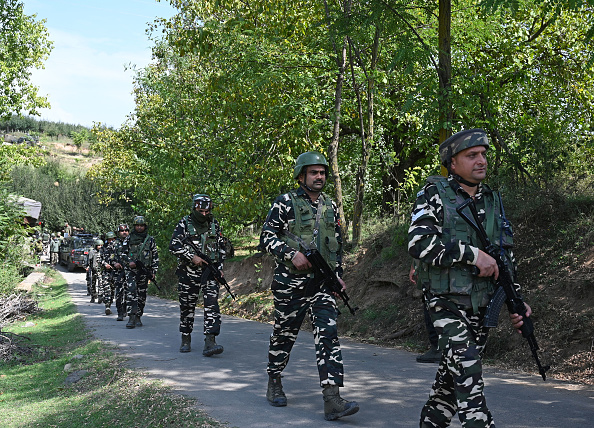
- 27 Sep 2024
In News:
The Armed Forces (Special Powers) Act (AFSPA) is a controversial law that grants extraordinary powers to the armed forces in designated "disturbed areas." Recently, the Ministry of Home Affairs extended AFSPA for six months in parts of Nagaland and Arunachal Pradesh, highlighting ongoing security concerns in these regions.
Current Status of AFSPA
Extended Areas
- Nagaland: AFSPA has been extended to eight districts—Dimapur, Niuland, Chumoukedima, Mon, Kiphire, Noklak, Phek, and Peren—along with 21 police stations in additional districts.
- Arunachal Pradesh: The Act continues in Tirap, Changlang, and Longding districts, as well as in certain areas of Namsai district.
Duration of Extension
The current extension is effective from October 1, 2024, lasting for six months unless revoked earlier. These areas were initially declared "disturbed" on April 1, 2024.
About AFSPA
Objective
AFSPA aims to maintain law and order in regions affected by insurgency or unrest, providing armed forces with necessary powers to perform their duties.
Key Provisions
- Section 3: Empowers the Governor or the Central Government to declare areas as "disturbed."
- Section 4: Grants special powers for arrests and searches without warrants.
- Section 6: Mandates that arrested individuals and seized property be handed over to the police.
- Section 7: Prosecution of armed forces personnel requires prior approval from the Central Government.
Rationale for Implementation
- To enable effective counter-insurgency operations.
- To ensure the protection of armed forces members.
- To uphold national security and sovereignty.
Criticisms and Issues
AFSPA has faced significant backlash for:
- Violating Fundamental Rights: Critics argue it undermines Articles 14, 19, and 21 of the Constitution.
- International Law Conflicts: It is perceived as contrary to the Universal Declaration of Human Rights and the International Covenant on Civil and Political Rights.
- Erosion of State Autonomy: The Act is viewed as an infringement on state powers, even in peaceful contexts.
Ineffectiveness and Atrocities
Reports of human rights abuses and the ineffectiveness of AFSPA in genuinely countering insurgency raise questions about its continued application.
Government's Position
Union Home Minister Amit Shah has noted that AFSPA has been lifted from 70% of the northeastern states, but it remains in force in certain areas, including Jammu and Kashmir, where revocation is also being considered.
Jeevan Reddy Committee
On November 19, 2004, the Central Government established a five-member committee led by Justice B.P. Jeevan Reddy to assess the Armed Forces (Special Powers) Act (AFSPA) in northeastern states. The committee was tasked with reviewing the law's implications and effectiveness.
Key Findings
In its 2005 report, the Jeevan Reddy Committee made several critical observations and recommendations:
- Complete Repeal: The committee advocated for the complete repeal of AFSPA, labeling it a "symbol of hate and oppression" and describing it as an "instrument of high-handedness."
- Incorporation into Other Legislation: It suggested that relevant provisions of AFSPA be integrated into the Unlawful Activities (Prevention) Act, 1967, with necessary modifications to delineate the powers of armed and paramilitary forces.
- Establishment of Grievance Cells: The committee recommended the creation of grievance cells in each district where armed forces are deployed, aimed at addressing public complaints and concerns regarding military actions.
Additional Recommendations
- The 5th report of the Second Administrative Reforms Commission also echoed the call for repealing AFSPA, reinforcing the need for legislative reform in addressing security issues.
- In 2016, the Supreme Court ruled that the armed forces cannot evade investigation for alleged excesses committed during their duties, even in "disturbed areas." This ruling clarified that the legal protections offered by AFSPA are not absolute, emphasizing accountability.
Conclusion
AFSPA remains a contentious issue with significant implications for civil rights, regional stability, and national security. A careful review and possible reform of the Act are essential to balance security needs with the protection of fundamental rights.
TRIPURA'S INSURGENCY RESOLUTION: A LANDMARK DECLARATION
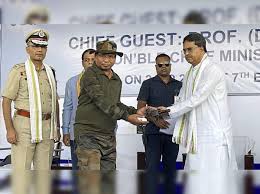
- 25 Sep 2024
In News:
Recent Developments
Insurgency-Free Declaration
Tripura Chief Minister Manik Saha has officially declared the state "insurgency-free" following a significant surrender ceremony where 584 militants from the National Liberation Front of Tripura (NLFT) and the All-Tripura Tiger Force (ATTF) laid down their arms.
Memorandum of Settlement
This milestone follows a Memorandum of Settlement signed on September 4 between the central government and various insurgent groups, witnessed by the union home minister. The Tripura government has successfully facilitated 12 peace accords over the last decade, leading to over 10,000 insurgents surrendering.
Understanding Insurgency in Tripura
Historical Context
Tribal Composition
Tripura is home to 19 indigenous tribes, including the Tripra, Reang, and Jamatia, with Kok Borok as the primary language alongside other Tibeto-Burmese dialects.
Journey to Statehood
- Accession: Tripura became part of the Indian Union on October 15, 1949.
- Union Territory: It was designated as a Union Territory on November 1, 1956.
- Statehood: Tripura attained full statehood on January 21, 1972.
Causes of Insurgency
- Demographic Changes: A significant influx of Bengali refugees from East Pakistan resulted in the indigenous population declining from 95% in 1931 to 31% by 1991.
- Tribal Discontent: The tribal population lost control over land and resources, leading to widespread grievances.
- Socio-Economic Factors: Issues such as geographic isolation, socio-economic challenges, corruption, and tribal land alienation fueled unrest.
Evolution of Political Movements and Insurgency
Formation of Political Organizations
- TUJS: Established in 1967 to advocate for tribal rights and autonomy.
- Armed Struggle: The Tripura Sena emerged in 1970, followed by the Tripura National Volunteers (TNV) in 1978, both pushing for an independent tribal state.
Rise of Insurgent Groups
Key groups involved include:
- TUJS: Formed in 1971.
- TNV: Established in 1981.
- NLFT: Founded in 1989.
- ATTF: Formed in 1990.
Communal Clashes and Military Response
- Opposition from Bengali Population: Groups like Amra Bangali emerged in opposition to tribal demands, leading to violent clashes with over 1,800 fatalities.
- Military Intervention: The Indian Army was deployed in 1980 to restore order.
Attempts at Peace and Resurgence of Militancy
TNV Settlement
The TNV signed a peace agreement with the state government in 1988, focusing on restoring tribal lands. However, issues with implementation led to the rise of new militant groups.
Resurgence of Insurgency
Between 1996 and 2004, insurgency gained traction, supported by logistics from Bangladesh and external networks, leveraging the region's challenging geography.
Strategic Response to Insurgency
- Counter-Insurgency Operations
- The state focused on effective counter-insurgency operations involving local police and paramilitary forces, minimizing the need for military deployment.
- Psychological Operations
- Efforts were made to shift perceptions among tribal communities, exposing the exploitative nature of insurgents.
- Confidence-Building Measures
- Rehabilitation packages and public appeals by state leaders encouraged insurgents to reintegrate into society.
- Civic and Developmental Initiatives
- Comprehensive development initiatives were implemented, enhancing healthcare, connectivity, and job opportunities, alongside civic action programs by security forces.
- Political and Governance Reforms
- Strengthening local governance through autonomous councils and encouraging tribal participation aimed to foster a more inclusive development process.
Conclusion
Tripura's journey to overcome insurgency highlights the effectiveness of a multi-faceted approach, combining socio-economic development with strategic military and political initiatives. The state's experience illustrates that insurgency can be addressed through sincere leadership and a balanced focus on military and socio-economic challenges.
Evaluating India's Current Competition Law Amid Proposed Digital Framework

- 15 May 2024
Why is it in the News?
It stated that due to the swift evolution of digital markets, the current competition law framework may not timely address the anti-competitive conduct by large digital enterprises.
Context:
- The Committee on Digital Competition Law (CDCL), recently released its report recommending a new Digital Competition Law for India alongside the Draft Digital Competition Bill (DCB).
- The genesis of the report goes back to the 53rd Report of the Parliamentary Standing Committee on Finance (PSC), released in December 2022.
- The PSC Report acknowledged the unique dynamics of digital markets, noting their strong network effects and concentration.
- It highlighted that the current competition law framework may not address anti-competitive conduct by large digital enterprises in a timely manner due to the rapid evolution of digital markets.
- Consequently, the report emphasized the need for a new law to restrict certain leading players from engaging in specific anti-competitive activities that could distort competition.
- Activities such as self-preferencing, bundling and tying, and deep discounting were highlighted as areas of concern.
Key Proposals of the Draft Digital Competition Bill:
Predictive regulation:
- The dynamic nature of digital markets, characterized by constant evolution and interconnected offerings, necessitates a shift from traditional ex-post regulation to a forward-looking, preventive, and presumptive ex-ante framework.
- The draft Bill proposes this proactive approach as the way forward, acknowledging the limitations of regulating market abuse after it has already occurred.
- India's current Competition Act of 2002 follows an ex-post antitrust framework, which has faced criticism for its delayed response to market abuse.
- By the time penalties are imposed, market conditions may have already changed, further disadvantaging smaller competitors.
- To effectively navigate the complexities of the digital realm, it is crucial to implement predictive regulation that identifies potential antitrust issues and establishes clear guidelines to mitigate harm and maintain a level playing field.
Significant entities:
- In the Bill, certain "core digital services," such as search engines and social media platforms, prompt the Competition Commission of India (CCI) to designate companies as "Systematically Significant Digital Enterprises (SSDEs)."
- This designation hinges on diverse quantitative and qualitative criteria, encompassing turnover, user base, and market influence.
- The quantitative thresholds for SSDE designation include:
- A turnover in India of at least Rs 4,000 crore over the last three financial years or a global turnover of at least $30 billion.
- A gross merchandise value in India of at least Rs 16,000 crore, or a global market capitalization of at least $75 billion.
- Additionally, the relevant core digital service should have a minimum of 1 crore end users or 10,000 business users.
- Entities falling outside these parameters may still be designated as SSDEs if the CCI deems their presence significant in any core digital service.
- SSDEs are prohibited from practices such as self-preferencing, anti-steering, and restricting third-party applications.
- Violations of these regulations may result in fines of up to 10% of their global turnover.
Associate Digital Enterprises:
- Recognizing the potential benefits of data sharing among entities within a major technology conglomerate, the Bill proposes to identify Associate Digital Enterprises (ADEs).
- Under this provision, if an entity within a group is identified as an associate entity, it would bear similar obligations as SSDEs, contingent upon its involvement with the core digital service provided by the primary company.
- For instance, consider the relationship between Google Search and Google Maps, where data flow from the former informs the functionalities of the latter.
- In this scenario, Google Maps could potentially be classified as an ADE.
- Similarly, the extent of data exchange between Google Search and YouTube could determine the classification of the latter as an ADE, depending on the recommendations provided to users.
Key Challenges with the Digital Competition Bill:
- Regulatory Approach: While the Digital Competition Bill (DCB) draws inspiration from international frameworks such as the UK's Digital Markets, Competition and Consumers Bill (DMCC) and the EU's Digital Markets Act, it could benefit from considering alternative approaches like Japan's "co-regulation" strategy.
- Integrating such an approach might foster a better balance between competition and innovation.
- Timeline: The current May 15, 2024 deadline for submitting comments may not provide sufficient time for a thorough analysis of the complex issues addressed by the DCB and its potential impacts on various stakeholders.
- A further extension of the consultation period should be considered.
- Inter-Regulatory Mechanisms: Overlaps between the DCB and existing sector-specific policy instruments need to be addressed.
- Implementing an inter-regulatory consultation mechanism will ensure clarity and a harmonized approach across regulatory bodies.
- Capacity Building: Strengthening the capacity of the Competition Commission of India (CCI) and its Digital Markets and Data Unit (DMDU) is crucial, particularly through the integration of technology sector experts.
- The DCB should outline specific measures to bolster the Commission's capacity and resources in order to effectively navigate the rapidly evolving digital landscape.
Need to Foster Digital Competition:
- Advocating for a Presumptive Framework: Government officials propose a shift towards a presumptive regulatory framework to address the entrenched pattern of anti-competitive behaviour by major tech companies.
- Notably, Google faced a substantial fine of Rs 1.337 crore from the CCI for its anti-competitive practices within the Android ecosystem.
- Concerns Over Tech Monopolies: Officials express apprehension over the dominance of a handful of US-based tech giants, which has stifled innovation over the past decade.
- High market barriers deter new entrants from challenging the dominance of established players, perpetuating a cycle of market concentration.
- Challenges for Emerging Players: Once a company secures a significant market share, its product often becomes the default choice for users, making it challenging for competitors to challenge its dominance.
- Even prominent entities like Spotify have raised concerns about the restrictive policies enforced by industry giants like Apple and Google.
- Niche Alternatives and Market Dynamics: While niche alternatives such as Signal for messaging and DuckDuckGo for search engines exist, they remain niche preferences rather than mainstream choices.
- The proliferation of big tech companies has facilitated affordable advertising rates for smaller businesses, but it has also intensified surveillance and data tracking practices, compromising user privacy.
Conclusion
The proposed DCB marks a notable stride towards regulating India’s digital markets. However, certain concerns persist about its content and policymaking mechanism. The timeline for stakeholder consultation is inadequate, necessitating an extension to ensure comprehensive feedback. Additionally, implementing inter-regulatory mechanisms and capacity building for the CCI remains critical to effectively navigating the evolving digital landscape. Therefore, addressing these issues will be pivotal in ensuring a progressive digital competition framework in India.
An AI-infused World Needs Matching Cybersecurity
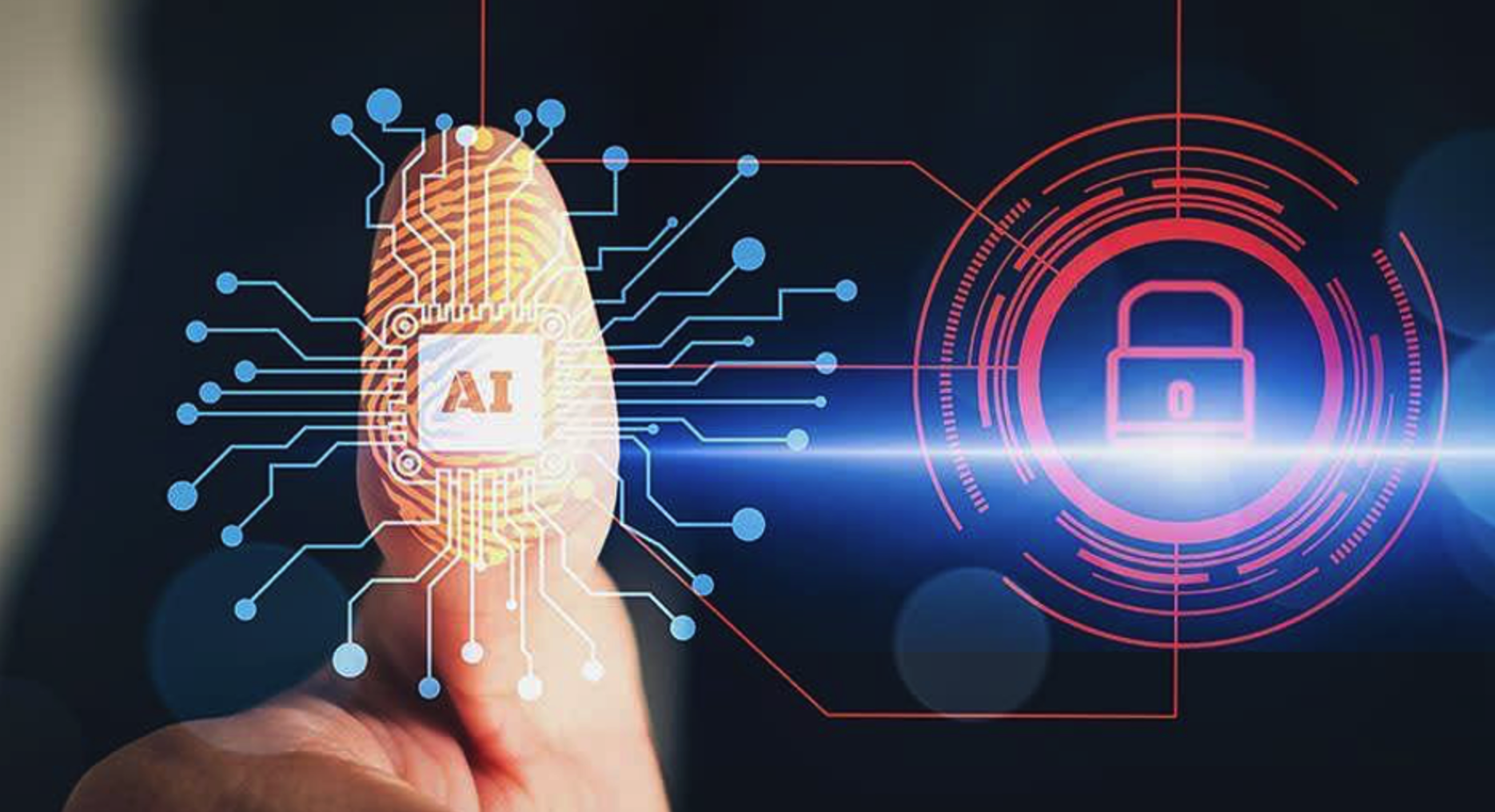
- 10 May 2024
Why is it in the News?
As generative AI technology becomes more prevalent, safeguarding consumers' ability to navigate digital environments securely has become increasingly imperative.
Context:
- In recent times, the integration of generative artificial intelligence (AI) across industries has significantly transformed operational processes.
- However, this rapid advancement has also led to the emergence of new cyber threats and safety concerns.
- With incidents such as hackers exploiting generative AI for malicious purposes, including impersonating kidnappers, it is evident that a comprehensive analysis and proactive approach are required to address and mitigate the potential risks associated with this technology.
- A study by Deep Instinct revealed that 75% of professionals observed a surge in cyberattacks over the past year, with 85% attributing this escalation to generative AI.
- Among surveyed organizations, 37% identified undetectable phishing attacks as a major challenge, while 33% reported an increase in the volume of cyberattacks.
- Additionally, 39% of organizations expressed growing concerns over privacy issues stemming from the widespread use of generative AI.
Significant Impact of Generative AI & Growing Cybersecurity Challenges:
- Transformative Impact: Generative AI has revolutionized various sectors like education, banking, healthcare, and manufacturing, reshaping our approach to operations.
- However, this integration has also redefined the landscape of cyber risks and safety concerns.
- Economic Implications: The generative AI industry's projected contribution to the global GDP, estimated between $7 to $10 trillion, underscores its significant economic potential.
- Yet, the development of generative AI solutions, such as ChatGPT introduced in November 2022, has introduced a cycle of benefits and drawbacks.
- Rising Phishing and Credential Theft: An alarming surge of 1,265% in phishing incidents/emails and a 967% increase in credential phishing since late 2022 indicates a concerning trend.
- Cybercriminals exploit generative AI to craft convincing emails, messages, and websites, mimicking trusted sources to deceive unsuspecting individuals into divulging sensitive information or clicking on malicious links.
- Emergence of Novel Cyber Threats: The proliferation of generative AI has expanded the cyber threat landscape, enabling sophisticated attacks.
- Malicious actors leverage AI-powered tools to automate various stages of cyber-attacks, accelerating their pace and amplifying their impact.
- This automation poses challenges for detection and mitigation, making attacks more challenging to thwart.
- Challenges for Organizations: Organizations across sectors face escalating cyber threats, including ransomware attacks, data breaches, and supply chain compromises.
- The interconnected nature of digital ecosystems exacerbates the risk, as vulnerabilities in one system can propagate to others, leading to widespread disruption and financial losses.
- Additionally, cybercriminals' global reach and anonymity pose challenges for law enforcement and regulatory agencies.
The Bletchley Declaration: Addressing AI Challenges
- Global Significance: The Bletchley Declaration represents a pivotal global initiative aimed at tackling the ethical and security dilemmas associated with artificial intelligence, particularly generative AI.
- Named after Bletchley Park, renowned for its British code-breaking endeavours during World War II, the declaration embodies a collective resolve among world leaders to shield consumers and society from potential AI-related harms.
- Acknowledgement of AI Risks: The signing of the Bletchley Declaration at the AI Safety Summit underscores the mounting awareness among global leaders regarding AI's inherent risks, notably in the cybersecurity and privacy realms.
- By endorsing coordinated efforts, participating nations affirm their dedication to prioritizing AI safety and security on the international agenda.
- Inclusive Engagement: The Bletchley Declaration's inclusive nature is evident in the involvement of diverse stakeholders, including major world powers like China, the European Union, India, and the United States.
- By fostering collaboration among governments, international bodies, academia, and industry, the declaration facilitates cross-border and cross-sectoral knowledge exchange, essential for effectively addressing AI challenges and ensuring equitable regulatory frameworks.
- Consumer Protection Focus: At its heart, the Bletchley Declaration underscores the imperative of safeguarding consumers against AI-related risks.
- Participating countries commit to formulating policies and regulations that mitigate these risks, emphasizing transparency, accountability, and oversight in AI development and deployment.
- Additionally, mechanisms for redress in cases of harm or abuse are prioritized.
- Ethical AI Promotion: A core tenet of the Bletchley Declaration is the promotion of ethical AI practices.
- Participating nations pledge to uphold principles of fairness, accountability, and transparency in AI development and usage, striving to prevent discriminatory or harmful outcomes.
- This commitment aligns with broader endeavours to ensure responsible AI deployment for the betterment of society.
Alternative Measures for AI Risk Mitigation:
- Institutional-Level Strategies: Governments and regulatory bodies can enact robust ethical and legislative frameworks to oversee the development, deployment, and utilization of generative AI technologies.
- These frameworks should prioritize consumer safeguarding, transparency, and accountability, all while fostering innovation and economic prosperity.
- Furthermore, the integration of watermarking technology can aid in the identification of AI-generated content, empowering users to discern between authentic and manipulated information.
- This proactive approach can substantially mitigate the prevalence of misinformation and cyber threats stemming from AI-generated content.
- Continuous Innovation and Adaptation: Sustained investment in research and development is imperative to proactively address emerging cyber threats and devise innovative solutions to counter them.
- By bolstering support for cutting-edge research in AI security, cryptography, and cybersecurity, governments, academia, and industry can drive technological progress that fortifies cybersecurity resilience and mitigates the inherent risks associated with generative AI.
Conclusion
Effectively tackling the challenges presented by generative AI demands a comprehensive strategy encompassing regulatory, collaborative, and educational efforts across institutional, corporate, and grassroots domains. Through the enactment of robust regulatory frameworks, stakeholders can collaboratively mitigate the risks posed by AI-driven cyber threats, fostering a safer and more secure digital environment for all.
Left Wing Extremism/Naxalism in India

- 17 Apr 2024
Why is it in the News?
At least 29 Maoists were killed and three security personnel were injured in a gunbattle recently in a forest in Kanker district of Bastar division in Chhattisgarh.
Context:
- In a significant development, at least 29 Maoists were neutralized, and three security personnel sustained injuries during a fierce gun battle in a forested area of the Kanker district in Chhattisgarh's Bastar division.
- This successful joint operation, conducted by the District Reserve Guards (DRG) and the Border Security Force (BSF), marked the highest number of Maoist casualties recorded in a single operation within the Bastar region.
- The operation involved a strategic collaboration between the DRG, a specialized anti-Naxal force, and the BSF, with a well-executed plan that allowed them to engage and ultimately overpower the Maoists.
What is Left Wing Extremism?
- Left-Wing Extremism (LWE), also referred to as left-wing terrorism or radical left-wing movements, encompasses political ideologies and groups that aim to achieve substantial societal and political transformation through revolutionary methods.
- These groups may resort to targeting government institutions, law enforcement agencies, or private property to advance their objectives.
- India's LWE movement traces its origins back to the 1967 uprising in Naxalbari, West Bengal, which set the stage for the emergence of various left-wing extremist groups.
- According to the Ministry of Home Affairs, LWE has impacted 90 districts across 10 states, with varying degrees of influence.
Maoist Presence Across India:
Maoist influence varies in intensity across different Indian states:
- Severely Affected States: Chhattisgarh, Jharkhand, Odisha, and Bihar face significant Maoist presence and activities, with frequent attacks on security forces and civilians.
- Partially Affected States: West Bengal, Maharashtra, and Andhra Pradesh experience a more moderate Maoist presence, with occasional incidents and clashes.
- Slightly Affected States: Uttar Pradesh and Madhya Pradesh have a lower level of Maoist activity but are still considered areas of concern.
- The Communist Party of India (Maoist) has been attempting to expand its influence in the southern states of Kerala, Karnataka, and Tamil Nadu, aiming to connect the Western and Eastern Ghats.
- Additionally, incursions into Assam and Arunachal Pradesh have raised concerns about long-term strategic implications.
Factors Contributing to Left-Wing Extremism in India:
Several underlying factors contribute to the rise and persistence of Left-Wing Extremism (LWE) in India:
- Inequitable Development: Many LWE-affected regions are among India's least developed areas, characterized by high poverty, unemployment, illiteracy, malnutrition, and social exclusion rates.
- LWE groups often exploit the grievances of marginalized communities, particularly tribal populations, who have been deprived of land, forest, and mineral rights.
- Marginalization: Naxalites primarily consist of Dalits, Adivasis, and other marginalized sections of society.
- Maoist teachings deeply influence their leadership, with land reforms and economic development being key issues.
- Governance Deficit: LWE-affected areas often suffer from inadequate governance, administration, and service delivery.
- Weak or corrupt state institutions leave a vacuum that LWE groups can exploit.
- These groups also use violence and intimidation to disrupt democratic processes, including elections, local governance, and development schemes.
- Ideological Appeal: LWE groups claim to represent the interests of oppressed and exploited classes, promoting a radical ideology that rejects parliamentary democracy and advocates for armed revolution.
- Drawing inspiration from Mao Zedong and the 1967 Naxalbari uprising, these groups may also have links to other extremist and separatist movements in India and abroad.
- Globalization and Cultural Displacement: The impacts of globalization, such as cultural changes and displacement, can cause feelings of dislocation and alienation.
- Left-wing extremist movements may offer identity and purpose to individuals marginalized by global forces.
- Support Base: The Naxalite movement draws support from the landless, sharecroppers, agricultural laborers, Harijans, and tribals.
- As long as these groups continue to face exploitation and social injustice, the Naxalite support base will persist.
The Challenges Posed by Naxalites to India:
The Naxalite movement presents several challenges to India's stability and development:
- Vulnerability to External Threats: Naxalite activities expose India's internal vulnerabilities, potentially inviting external threats.
- The CPI (Maoist) has close ties with Northeast insurgent groups, many of which have links to external forces hostile to India.
- The CPI (Maoist) has also expressed solidarity with Jammu and Kashmir terrorist groups.
- Impediments to Economic Development: Focusing on India's poor and marginalized regions, Naxalite activities hinder economic development efforts crucial for improving these areas' conditions.
- Internal stability is essential for a nation's economic progress.
- Additional Internal Security Expenses: Scarce resources are diverted towards defense and internal security to counter Naxalite threats, which could be better utilized for social development initiatives.
- Adverse Impact on Governance: Naxalite domination in certain areas disrupts governance through violent tactics, such as killings, kidnappings, intimidation, and extortion.
- This hampers the delivery of essential services to citizens in affected regions.
Steps Taken by the Government to Counter Left-Wing Extremism:
To tackle the challenges posed by Left-Wing Extremism (LWE), the Indian government has implemented various strategies and initiatives:
- Deployment of Central Armed Police Forces (CAPFs): CAPF battalions and Naga Battalions (BNs) are deployed to support state police forces in LWE-affected areas, providing additional security and resources.
- Security Related Expenditure (SRE) Scheme: The SRE scheme funds the recurring expenditures related to insurance, training, and operational needs of security forces, rehabilitation of surrendered LWE cadres, and awareness campaigns against violence.
- Review and Monitoring Mechanisms: The Ministry of Home Affairs regularly monitors the LWE situation at multiple levels through various review and monitoring mechanisms.
- Strengthening Intelligence Gathering: Intelligence capabilities at the central and state levels have been bolstered through measures like intelligence sharing via the Multi-Agency Centre (MAC) and State Multi-Agency Centre (SMAC) on a 24/7 basis.
- Inter-state Coordination: Given the cross-border nature of Maoist operations, the government facilitates frequent meetings and interactions between officials from bordering LWE-affected districts to enhance inter-state coordination.
- Countering Improvised Explosive Devices (IEDs): As IEDs are a significant threat, the Home Ministry has developed a Standard Operating Procedure (SOP) on explosives, IEDs, and landmines in affected areas, which has been shared with stakeholders for implementation.
- Enhanced Air Support: State governments and CAPFs have received increased air support, including UAVs and helicopters, for anti-Naxal operations and casualty evacuations.
Progress and Impact of the Measures:
- Over the past eight years, India has witnessed a substantial decrease in left-wing extremism violence and its geographical spread, thanks to the government's comprehensive measures:
- The number of left-wing extremism-related incidents dropped significantly in 2022 compared to 2013, totaling 413.
- Left-wing extremism-related deaths also experienced a substantial decline, with a 75% reduction from 397 in 2013 to 98 in 2022.
- The year 2022 saw a 33% decrease in resultant deaths and a 68% decrease in security forces' casualties compared to 2021.
Way Forward:
- Effective Implementation of PESA Act: Ensure proper and complete implementation of the Panchayats (Extension to Scheduled Areas) Act, 1996 (PESA) by issuing clear policy directives to empower gram sabhas.
- Align the Act with the historical and traditional tribal way of life and address implementation gaps that Maoists exploit.
- Tribal Empowerment and Representation: Foster tribal leadership by providing platforms for their voices to be heard and increasing representation in local governance structures and political processes.
- Address tribal communities' aspirations and ensure policies accommodate their unique needs and perspectives.
- Targeted Development Programs: Implement development programs addressing socio-economic issues faced by tribal communities, including infrastructure, healthcare, education, and employment opportunities. Involve local communities in participatory decision-making processes for initiatives.
- Counter Maoist Propaganda: Develop communication strategies to expose the gap between Maoist rhetoric and actions.
- Collaborate with local media, community leaders, and influencers to spread accurate information and counter misinformation.
- Negotiation and Conflict Resolution: Explore avenues for peaceful negotiation with moderate Maoist factions, identifying root causes of discontent and involving neutral mediators, civil society organizations, and respected community leaders in peacebuilding efforts.
- Human Rights Protection: Prioritize human rights protection in conflict zones, ensuring security measures align with the rule of law and minimizing collateral damage and civilian casualties.
- Long-term Strategic Planning: Develop a comprehensive, long-term strategy focused on sustainable development, social justice, and inclusive governance to address underlying issues contributing to the insurgency.
Conclusion
There is a widely acknowledged perspective that effectively addressing the Naxal issue requires a balanced approach involving both developmental and security measures. It's crucial not to solely consider it as a law and order challenge, as innocent tribal communities residing in remote forest areas often become targets of Naxal intimidation. Priority lies in re-establishing governance in Naxal-affected regions, fostering their development, and empowering marginalized communities to lead secure, dignified, and improved lives
Shaping India’s path to inclusive health care

- 08 Apr 2024
Why is it in the News?
World Health Day, which is observed every year on April 7, unites us around health equity, an essential topic at the heart of global health and justice.
Context:
- World Health Day, commemorated every April 7th, underscores the significance of health equity, acknowledged as a basic human entitlement by the World Health Organization (WHO).
- Hence, it is imperative to delve into the theme "My Health, My Right," delving into the hurdles and remedies in attaining health equity in India.
- As a country contending with multifaceted socioeconomic inequalities in healthcare access and results, this exploration becomes pivotal.
What is Health Equity?
- Health equity, as outlined by the WHO, embodies the principle that every person should have the opportunity to attain optimal health, irrespective of their social, economic, or environmental circumstances.
- It extends beyond mere healthcare access, addressing underlying factors such as poverty, discrimination, and resource imbalances.
- Considering Diverse Health Outcomes: A core tenet of health equity acknowledges that health results stem from a multifaceted interplay of elements, encompassing social, economic, and environmental determinants.
- Individuals from disadvantaged backgrounds often encounter obstacles like financial constraints, transportation limitations, and sparse healthcare facilities.
- The Vitality of Health Equity: Health equity holds paramount importance not only ethically but also from a public health standpoint.
- Research consistently indicates that societies fostering greater health equity typically enjoy superior health outcomes, marked by lower morbidity and mortality rates, reduced healthcare expenditures, and heightened life expectancy.
- Conversely, persistent health disparities may precipitate societal unrest, economic strains, and a squandered human potential.
Health Equity Challenges in India:
- Addressing Urban-Rural Disparities: India contends with pronounced healthcare inequalities between urban and rural regions, where urban areas typically boast superior healthcare infrastructure and services, while rural communities encounter obstacles like limited access to facilities, healthcare professionals, and infrastructure, resulting in inferior health outcomes compared to their urban counterparts.
- Navigating Overcrowded Urban Slums: Urban slums present profound challenges characterized by extreme poverty, overcrowding, unsanitary conditions, and inadequate access to clean water, fostering the spread of infectious diseases and escalating morbidity and mortality rates.
- Moreover, deficient healthcare infrastructure exacerbates health disparities as residents grapple with limited access to essential services.
- Tackling Socioeconomic and Caste Disparities: Marginalized groups, including Scheduled Castes, Scheduled Tribes, and economically disadvantaged populations, confront elevated rates of illness and death due to restricted healthcare access, diminished health literacy, and societal prejudice.
- These disparities intertwine with broader determinants like education, employment, and housing, perpetuating disparities in health outcomes.
- Confronting the Burden of Non-Communicable Diseases (NCDs): Non-communicable diseases (NCDs) such as cardiovascular ailments, diabetes, and cancer pose a mounting challenge to health equity in India, constituting a substantial portion of the disease burden.
- However, marginalized communities often face barriers to accessing preventive measures and NCD treatment, amplifying health inequalities and exacerbating existing socioeconomic gaps.
- Navigating Shortages in Healthcare Personnel: A severe shortage of healthcare professionals, with only 0.8 doctors per 1,000 individuals according to WHO data, exacerbates health challenges, particularly in rural areas where access to primary care is limited, resulting in delayed diagnoses, substandard treatment, and compromised health outcomes.
- Confronting Infrastructure and Resource Limitations: Inadequate healthcare infrastructure, insufficient funding, and resource limitations pose formidable obstacles to health equity in India, with many public facilities lacking essential equipment, medications, and skilled personnel.
- Furthermore, the unequal distribution of resources aggravates urban-rural healthcare disparities, exacerbating inequities in access to quality healthcare services.
Strategies and Measures to Advance Health Equity in India:
- Enhancing Primary Healthcare Services: A pivotal approach to fostering health equity in India involves bolstering primary healthcare provisions, especially in rural and marginalized regions.
- This entails augmenting the accessibility and availability of primary care facilities, fortifying the skills and capabilities of frontline healthcare personnel, and ensuring the delivery of essential health services encompassing preventive care, maternal and child healthcare, and management of chronic ailments.
- Initiatives such as the National Rural Health Mission (NRHM) and the National Urban Health Mission (NUHM) strive to extend primary healthcare access and mitigate healthcare disparities between urban and rural locales.
- Advocating for Universal Health Coverage: Universal health coverage (UHC) stands as a cornerstone in ensuring equitable access to indispensable healthcare services devoid of financial strains.
- Endeavors like Ayushman Bharat, India's flagship health insurance program, aspire to furnish financial safeguarding to vulnerable segments by offering comprehensive coverage for hospitalization expenses.
- By broadening the reach of quality healthcare services and alleviating out-of-pocket costs, UHC endeavors to redress discrepancies in healthcare accessibility and enhance health outcomes for all citizens.
- Targeting Social Determinants of Health: Attaining health equity mandates a multifaceted approach that transcends healthcare interventions to address the underlying social determinants of health, encompassing poverty, education, housing, and employment.
- Initiatives geared towards poverty mitigation, augmenting educational and sanitation access, and fostering livelihood opportunities can wield a transformative impact on health outcomes and help ameliorate health disparities.
- Programs like the Mahatma Gandhi National Rural Employment Guarantee Act (MGNREGA) furnish rural households with employment prospects, thereby fostering enhanced socioeconomic circumstances and superior health outcomes.
- Empowering through Health Literacy: Elevating health literacy assumes paramount significance in empowering individuals to make informed health decisions and pursue equitable healthcare access.
- Integration of health education within prevailing healthcare schemes can heighten public consciousness and advocate for preventive healthcare practices.
- Fostering Collaborative Endeavors: Efficacious collaboration among governmental bodies, civil society, healthcare providers, and international entities constitutes a linchpin in addressing health inequities.
- By harnessing their respective competencies and resources, these stakeholders can conceptualize culturally sensitive health initiatives tailored to the distinctive requisites of diverse communities.
Conclusion
Realizing health equity in India necessitates coordinated endeavors spanning various sectors and involving diverse stakeholders. Through targeted interventions addressing socioeconomic health determinants, bolstering healthcare infrastructure, and fostering collaborative alliances, India can progress towards a future where equitable access to superior healthcare becomes a universal norm. The pursuit of health equity transcends moral imperatives, emerging as a pivotal prerequisite for fostering sustainable development and societal advancement.
Contribution of Dr MS Swaminathan Towards Indian Agriculture (Indian Express)
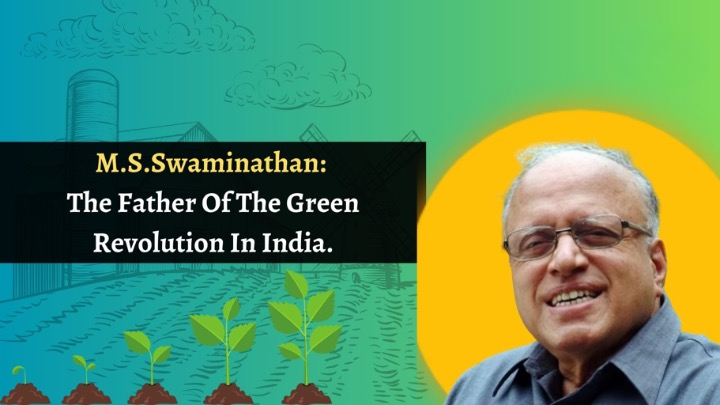
- 09 Feb 2024
Why is it in the News?
Recently, Prime Minister Modi announced that the agriculture scientist M S Swaminathan will be honoured with the Bharat Ratna.
Who was MS Swaminathan?
- Monkomb Sambasivan Swaminathan (MS Swaminathan) was born on August 7, 1925, in Kumbakonam, Madras Presidency (now Tamil Nadu).
- He was an agronomist, agricultural scientist, plant geneticist, administrator, and humanitarian.
- He was known as the ‘father of the Green Revolution’ in India.
- Swaminathan began his career in 1949 researching the genetics of potatoes, wheat, rice, and jute.
- He played a crucial role in developing high-yielding varieties of paddy that helped ensure India’s low-income farmers produced more yield.
- Also known as the ‘father of economic ecology’ by the United Nations Environment Programme, he worked with agriculture ministers including C Subramaniam and Jagjivan Ram during the 1960s and 70s for the success of the ‘Green Revolution’ in India.
- An initiative that paved the way for an exponential rise in the productivity of wheat and rice through the adaptation of chemical-biological technology.
- Career: Swaminathan also held administration positions in various agricultural research laboratories.
- He served as the director general of the Indian Council of Agricultural Research and International Rice Research Institute.
- He also worked as the principal secretary of the Ministry of Agriculture in 1979.
- Later, he also served as the President of the International Union of the Conservation of Nature and Natural Resources.
- In 2004, Swaminathan was appointed as chairman of the National Commission on Farmers.
- Awards and Recognition: He was awarded with the Ramon Magsaysay Award in 1971 and the Albert Einstein World Science Award in 1986.
- He was awarded the first World Food Prize in 1987, following which he set up the MS Swaminathan Research Foundation in Chennai.
- Swaminathan has also been conferred with the Padma Shri, Padma Bhushan, and Padma Vibhushan - the three most prestigious awards.
- Apart from these, he was also given the H K Firodia Award, the Lal Bahadur Shastri National Award, and the Indira Gandhi Prize.
- Swaminathan also contributed to various agricultural and environmental initiatives globally.
- He was named one of the 20 most influential Asians of the 20th century by Time magazine.
- He also served as a Member of Parliament in the Rajya Sabha from 2007 to 2013.
- MS Swaminathan passed away in September 2023 at the age of 98.
- His decision to focus on ensuring India's food security led him to become a key figure in the Green Revolution of the 1960s, which transformed India from a food-deficient nation to one of the world's leading agricultural producers.
- His collaboration with Nobel laureate Norman Borlaug introduced high-yielding varieties of wheat and rice, saving millions from starvation.
- Dr Swaminathan's transformative influence on Indian agriculture began to emerge when he championed the introduction of high-yielding crop varieties.
- His visionary approach was instrumental in pioneering the Green Revolution in India when the country was still grappling with poverty and a lack of social security.
- The impact of Dr. Swaminathan's efforts was nothing short of revolutionary.
- India's food production skyrocketed, and the nation moved from a state of food scarcity to food self-sufficiency.
- His work not only averted potential famines but also elevated the economic conditions of countless farming communities.
How MS Swaminathan Contributed to the Green Revolution?
- MS Swaminathan was greatly influenced by Mahatma Gandhi's teachings of selfless service to the poor and the nation.
- He was very much influenced by the 1943 Bengal famine, which killed up to three million people and realised the need to improve agriculture and food security in India.
- After Swaminathan’s work on rice, he and other scientists worked on doing the same to enhance productivity for the wheat crop.
- India had to get Norin dwarfing genes from Norman Borlaug in Mexico to enhance the productivity and adaptability of its wheat crops.
- These genes, known for their ability to produce shorter wheat plants, were instrumental in the Green Revolution, as they helped increase yield potential and improve resistance to lodging (falling over) in wheat plants.
- By acquiring these genes, India aimed to replicate the success of the Green Revolution and address food security challenges by boosting wheat production.
- Norman Borlaug was an American scientist who was working on developing more productive crop varieties.
- It led to him winning the Nobel Peace Prize in 1970 for his work in developing High Yielding Varieties (HYVs) of wheat.
- Many researchers and scientists were involved in this work but there isn’t any doubt that the basic strategic vision underpinning the Green Revolution in India, introducing a new genetic strain or ‘plant type’ responsive to increased fertiliser and water application came from MS Swaminathan.
- The problem with the traditional wheat and rice varieties was that they were tall and slender.
- These ‘lodged’ – fell flat on the ground — when they grew and their heads were heavy with well-filled grains produced in response to high fertiliser doses.
- Through Swaminathan’s research on rice, a reduction in plant height was sought to make them less lodging-prone but this was not easy to do.
- His strategy of developing semi-dwarf wheat varieties using mutagenesis exposing plants to chemicals or radiation to introduce desirable modifications in their DNA did not, however, work.
- The lowering of plant heights led to a simultaneous reduction in the size of the grain-bearing panicles or earheads.
- The search for an ideal variety led him to contact American scientist Orville Vogel.
- He played a role in developing a ‘dwarf wheat’ called Gaines, which had a high yield.
- It contained dwarfing genes from a dwarf wheat called the Norin-10.
- Vogel agreed but was unsure of the wheat’s potential in the Indian climate and thus advised Swaminathan to approach Norman Borlaug, who had incorporated the same dwarfing genes through Vogel’s lines into his spring wheat varieties in Mexico that were better suited for India.
- Borlaug also later visited India, after Swaminathan proposed so to the Indian Agricultural Research Institute, allowing for the wheat breeding programme to commence.
- In 1963, they began a serious effort to breed dwarf wheat and within five years, this initiative led to what became known as the "Wheat Revolution."
- Indira Gandhi, the then Prime Minister of India, released a special stamp to mark the achievement.
The Side Effects of the Green Revolution:
- Despite its landmark role in achieving food sufficient in India, the Green Revolution has been criticised on multiple counts, such as:
- Benefiting the already prosperous farmers as it was introduced in states with higher productivity.
- Swaminathan recognised such issues as early as January 1968, addressing the Indian Science Congress at Varanasi.
- He highlighted concerns about the rapid spread of a few high-yielding crop varieties replacing diverse local ones, leading to potential problems like soil degradation, desertification, excessive pesticide use, and unsustainable groundwater extraction.
- Unfortunately, many of these concerns have materialised today.
- He also lent his support to farmers as the head of the National Commission on Farmers from 2004-06, he recommended that the Minimum Support Price at which farmers sell their crops to the government should be at least 50 per cent more than the weighted average cost of production.
- For his contributions, Swaminathan was awarded the first World Food Prize Laureate in 1987, for “developing and spearheading the introduction of high-yielding wheat and rice varieties into India during the 1960s when that country faced the prospect of widespread famine.
- Wheat production doubled in just a few years, making the country self-sufficient and saving millions from extreme food deprivation.
Why Punjab moved SC against the expansion of BSF jurisdiction (Indian Express)
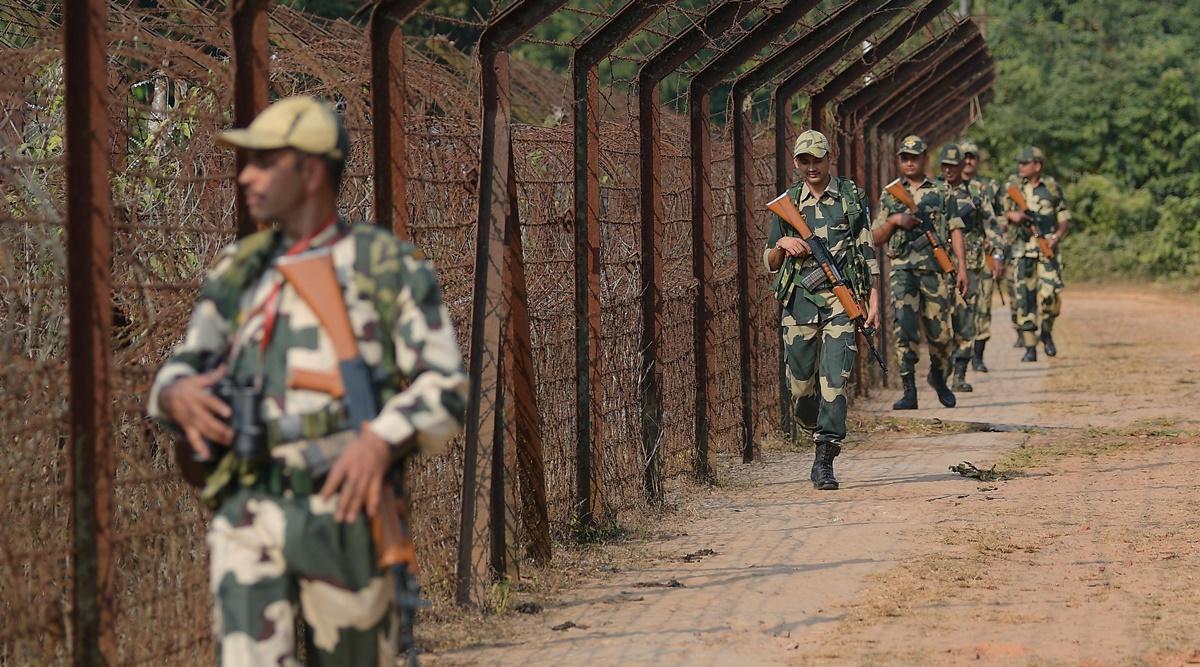
- 24 Jan 2024
Why is it in the News?
The Supreme Court is set to hear the dispute over the expansion of the Border Security Force (BSF) jurisdiction in Punjab.
Context:
- The Supreme Court will hear petitions filed by the Punjab government against the Centre’s notification expanding the jurisdiction of Border Security Forces (BSF) to 50 km from the international border in Punjab.
- This comes after the Centre in 2021 decided to expand the BSF’s jurisdiction to undertake search, seizure and arrest within a larger 50-kilometre stretch from the International Border compared to the earlier limit of 15 kilometres.
- The Centre had also decided to decrease the BSF’s area of operation in Gujarat from 80 kilometres from the border to just 50 kilometres.
What is the Border Security Force (BSF)?
- The BSF was established on 1 December 1965 after the India-Pakistan war.
- With a strength of about 2.65 lakh personnel, it has 192 operational battalions and deployed along the Pakistan and Bangladesh borders.
- It is the country’s largest border force and one of the Central Armed Police Forces of the Union of India under the administrative control of the Ministry of Home Affairs (MHA).
- The other forces include the Indo-Tibetan Border Police (ITBP), the Sashastra Seema Bal (SSB) and the Assam Rifles, Central Industrial Security Force (CISF), Central Reserve Police Force (CRPF) and National Security Guards (NSG).
- It also contributes dedicated services to the UN peacekeeping Mission by sending a large contingent of its trained manpower every year
- The BSF is meant to secure India’s borders with its neighbouring nations and is empowered to arrest, search and seize under a number of laws, such as the Criminal Procedure Code, the Passports Act, the Passport (Entry into India) Act, and the NDPS Act, to name a few.
Why was the BSF Jurisdiction Extended?
- Section 139(1) of the BSF Act allows the central government, through an order, to designate an area “within the local limits of such area adjoining the borders of India” where members of the BSF can exercise powers to prevent offences under any Acts that the central government may specify.
- Prior to the notification issued in October 2021, the BSF could exercise its powers within 15 kilometres of the border in Punjab, West Bengal and Assam.
- The Centre expanded this to within 50 kilometres of the border.
- The notification states that, within this larger 50-kilometre jurisdiction, the BSF can only exercise powers under the Criminal Procedure Code, the Passport (Entry into India) Act and the Passports Act.
- For other central legislations, the 15-km limit remains.
- This expansion was in response to the increased use of drones and Unmanned Aerial Vehicles, which have long-range capabilities and enable surveillance and the smuggling of arms and fake currency.
- The ‘menace of cattle smuggling’ and smugglers often seek refuge outside BSF jurisdiction.
- The centre also claimed that the notification makes the BSF jurisdiction uniform across states, as the 50-kilometre limit was already in place in Rajasthan.
- The same notification reduced the jurisdiction in Gujarat from 80 km to 50 km.
Why Punjab Challenged This Act?
- The state of Punjab filed an ‘original suit’ against the central government in the Supreme Court in December 2021 and alleged that the extension of the territorial jurisdiction of BSF encroaches upon its own constitutional jurisdiction.
- The Supreme Court has ‘original jurisdiction’ in disputes between the central government and states under Article 131 of the Constitution, which means cases of this kind can only be heard for the first time at the SC “to the exclusion of any other court”.
- The Punjab government claimed that expanding the jurisdiction of the BSF would compromise the state’s exclusive powers to legislate on matters involving the police and public order.
- These powers are provided in Entries 1 and 2 of the State List under Article 246 of the Constitution.
- They also claimed that the notification was issued without consulting with any of the states concerned.
How did Other States Respond?
- The states at the time had decried the move as an “irrational decision”, a “direct attack on federalism” and an attempt to “interfere through Central agencies”.
- Punjab and West Bengal denounced the move with the respective state Assemblies even passing resolutions against the Centre’s decision.
What are the Challenges Associated with Expanding Jurisdiction?
- Public Order vs. Security of State: Maintaining public order and policing, signifying peace, safety, and tranquillity, falls within the purview of State Governments (Entry 1 and Entry 2 of the State list, respectively).
- However, if a severe public disorder poses a threat to the security or defence of the State or the nation itself (Entry 1 of the Union list), it becomes a matter of concern for the Union Government as well.
- Federalism Strain: Issuing notifications without state government concurrence may be seen as an infringement on state powers.
- The Punjab Government argues that such notifications amount to the Centre encroaching under the pretext of security or development.
- Impact on BSF Operations: The extension of jurisdiction to policing in the hinterland contradicts the role of a border guarding force.
- This shift could potentially undermine the BSF's ability to fulfil its primary duty of guarding the international border.
Issues Specific to Punjab:
- Overlapping Powers: The extended 50 km jurisdiction grants concurrent power with state police over every cognizable offence under the Indian Penal Code (IPC).
- In a relatively small state like Punjab, this extension encompasses all major cities.
- In other states like Gujarat and Rajasthan, where the extension might be considered, Gujarat has substantial marshland, and extending jurisdiction there might be reasonable as it doesn't encompass major urban centres.
- Similarly, in Rajasthan, the presence of a desert reduces the impact of jurisdiction extension.
Way Ahead
- Emphasis on State Consent: Considering the security dynamics in India's vicinity, the existing collaboration between Central armed forces and State civil authorities remains suitable.
- Nonetheless, consulting with the State Government before deploying armed forces by the Union Government is recommended, whenever possible.
- State Empowerment: Each State Government, in coordination with the Union Government, should devise both short-term and long-term strategies to fortify its Armed Police.
- The aim is to achieve substantial self-reliance in managing Armed Police matters, necessitating the Central armed forces' intervention only during exceptionally severe disturbances.
- Regional Collaboration: Neighboring States can collaboratively establish a framework for utilizing each other's Armed Police in times of necessity through consensus.
- The Zonal Council stands out as the most apt platform for States within a zone to reach a consensus and formulate such arrangements.
Gig Economy and Gig Workers (Indian Express)
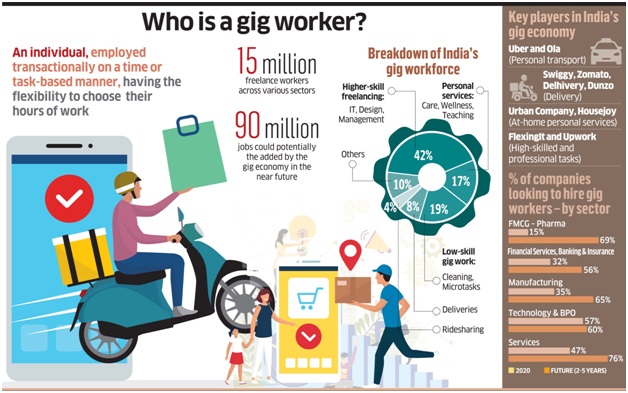
- 26 Jul 2023
Why in the News?
The Rajasthan government recently enacted the Rajasthan Platform Based Gig Workers (Registration and Welfare) Bill in the year 2023.
- Highlights of the Bill:
Rajasthan Platform-based Gig Workers Welfare Board will formulate welfare policies and address grievances of piece-rate gig workers.
- The board can determine the aggregator's cess percentage for the social welfare corpus, based on transaction volumes on the platform.
- Unique ID:
- All gig workers registered with any platform will automatically be registered with the board, receiving a unique ID valid for three years.
- Penalty:
- Violating data sharing and worker employment rules can result in fines up to 10 lakh for the first offense and up to 1 crore for subsequent ones.
- Suspension Authority:
- The board is authorized to recommend temporary or permanent suspension of errant aggregators in the state.
- Public Feedback:
- The draft Bill will soon be made available to the public for feedback, currently with the Law department.
- What is Gig Economy?
- The Gig economy offers flexible work arrangements, allowing individuals to take up short-term or part-time jobs based on their availability and preferences.
- It heavily relies on digital platforms and apps that connect gig workers with customers or clients seeking specific services.
- Many people engage in gig work to supplement their income or as a source of additional earnings, making it easier to diversify their income streams.
- The gig economy has faced controversies regarding worker rights, fair pay, and debates over whether gig workers should be classified as employees with access to employment benefits.
- Who are gig workers?
- As per the Code on Social Security, 2020, a gig worker is an individual who engages in work or work arrangements and earns from such activities independently, outside the scope of a conventional employer-employee relationship.
- Gig workers can be broadly classified into platform and non-platform-based workers.
- Platform Workers:
- These workers refer to individuals who perform tasks or services through online software apps or digital platforms like Zomato, Swiggy, Ola, and others.
- Non-platform Workers:
- These workers are typically casual wage and own-account workers in traditional sectors, working either part-time or full-time.
- Gig Economy in India:
- As per NITI Aayog's report titled 'India's Booming Gig and Platform Economy':
- Gig workers are individuals involved in income-earning activities beyond the conventional employer-employee arrangement and may also operate within the informal sector.
- According to a 2019 report by the India Staffing Federation, India is the fifth largest in flexi-staffing globally, after the US, China, Brazil and Japan.
- In 2020, approximately 7.7 million workers were actively engaged in the gig economy.
- The gig workforce is expected to grow significantly, reaching 23.5 million workers by the year 2029-30.
- Currently, around 47% of gig work falls under medium-skilled jobs, 22% in high-skilled, and 31% in low-skilled jobs.
- There is a noticeable trend showing a gradual decline in medium-skilled workers' concentration, while the number of low-skilled and high-skilled workers is on the rise.
- Challenges faced by Gig workers:
- Impact on Full-time Employment Growth: The gig economy trend can hinder the growth of full-time employment as some employers may prefer to hire contracted workers due to cost-effectiveness and flexibility.
- Disruption of Work-life Balance: For certain workers, the flexibility of gig work can lead to disruptions in work-life balance, affecting sleep patterns and daily activities.
- Potential Replacement of Full-time Employees: Freelance workers in the gig economy may replace the need for a higher number of full-time employees within a company.
- Lack of Job Security: In the gig economy, workers have a more entrepreneurial role, which means they may experience less job security with no guaranteed steady income, pay, or benefits.
- Absence of Regular Job Benefits: Employers often avoid providing benefits such as health coverage and paid vacation time to gig workers, as they are not part of a formal employment relationship with the platform company. This lack of benefits can make short-term contracts less appealing and challenging to include on resumes.
- Government Initiatives for Gig Workers India:
- Code of Social Security, 2020: The Government introduced the Code on Social Security, 2020, aiming to develop suitable social security schemes for gig workers and platform workers, covering aspects like life and disability insurance, accident coverage, health and maternity benefits, and old age protection.
- However, these provisions are yet to be implemented.
- e-Shram Portal: In 2021, the Government launched the e-Shram portal, designed for the registration and establishment of a Comprehensive National Database of Unorganized Workers, including gig workers and platform workers.
- This portal facilitates self-declaration registration for individuals engaged in approximately 400 different occupations.
- Way Forward
The Gig Economy holds promising opportunities for India's extensive workforce, particularly for low-skilled laborers. To harness its potential, the Government should take proactive measures to foster the growth of gig economy platforms. Simultaneously, safeguarding the welfare of gig workers is crucial, ensuring fair working conditions and access to social security benefits. Striking this balance will require collaborative efforts from all stakeholders involved.
- Mains Question:
Discuss the Government's role in supporting the Gig Economy while safeguarding gig workers' interests. How can a balance be achieved between promoting the gig economy and protecting the welfare of gig workers? (20 M)
